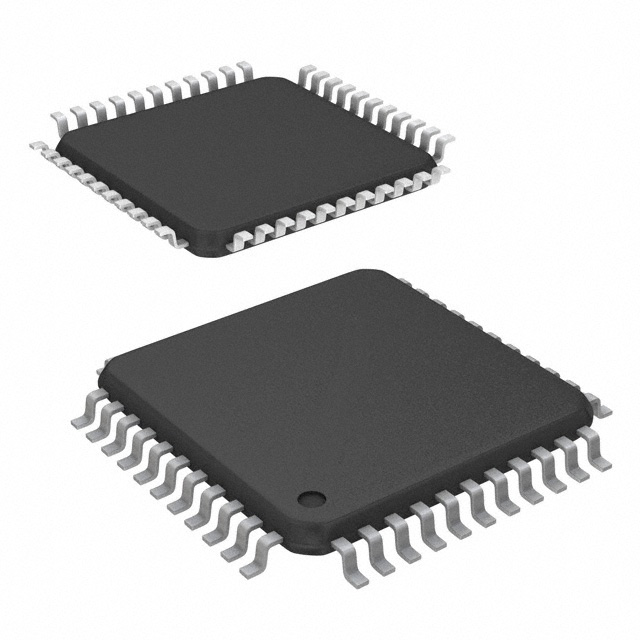AT90S4414-4AI
Product Overview
Category
AT90S4414-4AI belongs to the category of microcontrollers.
Use
This microcontroller is commonly used in various electronic applications that require embedded control and processing capabilities.
Characteristics
- High-performance 8-bit RISC architecture
- Low power consumption
- Wide operating voltage range
- Integrated on-chip peripherals
- Flash memory for program storage
- EEPROM for data storage
- Multiple communication interfaces
- Real-time clock functionality
Package
AT90S4414-4AI is available in a compact and durable package, suitable for surface mount technology (SMT) applications.
Essence
The essence of AT90S4414-4AI lies in its ability to provide efficient and reliable control and processing capabilities in a wide range of electronic devices.
Packaging/Quantity
AT90S4414-4AI is typically packaged in reels or trays, with quantities varying based on customer requirements.
Specifications
- Architecture: 8-bit RISC
- Operating Voltage: 2.7V to 5.5V
- Flash Memory: 4KB
- EEPROM: 256 bytes
- RAM: 256 bytes
- Clock Speed: Up to 4 MHz
- Communication Interfaces: UART, SPI, I2C
- Timers/Counters: 2 x 8-bit, 1 x 16-bit
- Analog-to-Digital Converter: 10-bit resolution, 8 channels
- Operating Temperature Range: -40°C to +85°C
Detailed Pin Configuration
The AT90S4414-4AI microcontroller has a total of 44 pins. The pin configuration is as follows:
- Port A (PA0-PA7)
- Port B (PB0-PB7)
- Port C (PC0-PC7)
- Port D (PD0-PD7)
- Reset Pin (RESET)
- Crystal Oscillator Pins (XTAL1, XTAL2)
- Power Supply Pins (VCC, GND)
Functional Features
- High-speed processing capabilities
- On-chip memory for program and data storage
- Integrated peripherals for various applications
- Flexible communication interfaces for data exchange
- Real-time clock functionality for time-sensitive applications
- Low power consumption for energy-efficient designs
Advantages and Disadvantages
Advantages
- Efficient and reliable control capabilities
- Wide operating voltage range allows for versatile applications
- Integrated peripherals reduce the need for external components
- Flash memory enables easy program updates
- Low power consumption prolongs battery life in portable devices
Disadvantages
- Limited program and data storage capacity compared to higher-end microcontrollers
- Relatively lower clock speed may limit performance in demanding applications
- Lack of advanced features found in more advanced microcontroller models
Working Principles
AT90S4414-4AI operates based on an 8-bit RISC architecture. It executes instructions stored in its flash memory, utilizing the integrated peripherals and registers to perform various tasks. The microcontroller communicates with external devices through its communication interfaces, enabling data exchange and control.
Detailed Application Field Plans
AT90S4414-4AI finds applications in a wide range of fields, including but not limited to: - Home automation systems - Industrial control systems - Automotive electronics - Medical devices - Consumer electronics - Internet of Things (IoT) devices
Detailed and Complete Alternative Models
Some alternative microcontroller models that offer similar functionalities to AT90S4414-4AI include: - ATmega16 - PIC16F877A - STM32F103C8T6 - MSP430G2553 - LPC1768
These alternative models provide a range of options with varying specifications and features, allowing designers to choose the most suitable microcontroller for their specific application.
Word count: 515 words
Lista 10 Vanliga frågor och svar relaterade till tillämpningen av AT90S4414-4AI i tekniska lösningar
Sure! Here are 10 common questions and answers related to the application of AT90S4414-4AI in technical solutions:
Q: What is the AT90S4414-4AI microcontroller used for? A: The AT90S4414-4AI is a microcontroller commonly used in embedded systems for various applications, including industrial automation, robotics, and consumer electronics.
Q: What is the operating voltage range of the AT90S4414-4AI? A: The AT90S4414-4AI operates within a voltage range of 2.7V to 5.5V.
Q: How much flash memory does the AT90S4414-4AI have? A: The AT90S4414-4AI has 4KB of flash memory for storing program code.
Q: Can I interface the AT90S4414-4AI with external devices? A: Yes, the AT90S4414-4AI has multiple I/O pins that can be used to interface with external devices such as sensors, actuators, and displays.
Q: Does the AT90S4414-4AI support analog inputs? A: No, the AT90S4414-4AI does not have built-in analog-to-digital converters (ADCs), so it cannot directly process analog signals. However, external ADCs can be used for this purpose.
Q: What communication interfaces are supported by the AT90S4414-4AI? A: The AT90S4414-4AI supports serial communication protocols such as UART (Universal Asynchronous Receiver-Transmitter) and SPI (Serial Peripheral Interface).
Q: Can I use the AT90S4414-4AI for real-time applications? A: Yes, the AT90S4414-4AI has a built-in timer/counter that can be used for timekeeping and generating precise timing intervals, making it suitable for real-time applications.
Q: What programming language is used to program the AT90S4414-4AI? A: The AT90S4414-4AI can be programmed using C or assembly language.
Q: Is the AT90S4414-4AI compatible with Arduino? A: No, the AT90S4414-4AI is not directly compatible with the Arduino platform. However, it can be programmed using AVR-specific development tools.
Q: Can I use the AT90S4414-4AI in battery-powered applications? A: Yes, the low operating voltage range of the AT90S4414-4AI makes it suitable for battery-powered applications where power efficiency is important.
Please note that these answers are general and may vary depending on specific application requirements and implementation details.


